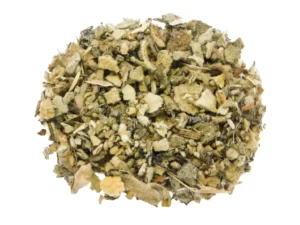Table of Contents
Mullein Leaf: A Comprehensive Guide to Its Benefits and Uses
What is Mullein?
Mullein refers to over 300 species of the genus Verbascum, known for their tall, velvety leaves and vibrant yellow flowers. The most common species, Verbascum thapsus, is widely recognized in traditional herbal medicine. Common names include Aaron’s Rod, Adam’s Flannel, and American Mullein. Historically, the plant has been valued for its medicinal and non-medicinal uses, including creating dyes and torches.
This versatile herb is easily accessible and can be found in grocery stores, health shops, or even growing wild. Traditionally, its leaves, flowers, and roots have been used to create teas, tinctures, and oils to address various ailments.

Mullein Leaf: Benefits, Uses, and Insights into a Herbal Remedy
Key Components and Medicinal Properties
Scientific studies reveal that mullein contains compounds such as flavonoids, saponins, tannins, terpenoids, glycosides, and mucilage. These components contribute to its antioxidant, anti-inflammatory, and expectorant properties.
The mucilage, approximately 3% of the plant, is believed to soothe mucous membranes, while the saponins contribute to its ability to loosen and expel mucus. Despite its widespread use, most claims lack extensive human-based research, emphasizing the need for more scientific validation.
Top Uses of Mullein Leaf
1. Lung and Respiratory Support
Mullein is renowned for its role in supporting respiratory health. Its compounds help reduce inflammation and expel mucus, making it beneficial for conditions like bronchitis, asthma, and sore throat. A simple mullein tea or syrup can provide relief for these ailments.
2. Ear Infections
Known for its analgesic and antibacterial properties, mullein is a key ingredient in natural ear drop formulations. Studies suggest its effectiveness in managing ear pain and infections, comparable to synthetic anesthetics.
3. Joint Pain Relief
Traditionally, mullein tea has been used to alleviate joint pain caused by inflammation. Research suggests that the plant’s compounds may slow cartilage damage, making it a potential remedy for conditions like osteoarthritis.
4. Skin Burns and Wound Healing
Mullein-based ointments are often applied to burns, wounds, and bruises. The plant’s anti-inflammatory and soothing properties may aid in faster healing and reduce irritation.
How to Use Mullein
Mullein Tea
A popular way to consume mullein is through tea. To prepare, steep 1–2 teaspoons of dried leaves in a cup of boiling water for 10–15 minutes. This tea is known to soothe sore throats and alleviate cold symptoms.
Mullein Oil
Mullein oil is created by infusing the plant in carrier oils like olive oil. It’s often used as ear drops or applied topically for skin conditions. To prepare at home, either use a hot or cold extraction method.
Mullein Supplements
Mullein capsules are commonly marketed for lung and immune health. While these products are convenient, consult a healthcare provider before use, especially if you’re taking other medications.
Historical Significance of Mullein
Mullein has been used since ancient times for its therapeutic properties. Dioscorides, a Greek physician, recommended it for lung diseases. In Ireland, boiled mullein leaves were traditionally consumed for tuberculosis, while in Appalachia, the plant was used to treat colds and infections.
Potential Side Effects and Interactions
When used correctly, mullein has minimal side effects. However, individuals with allergies or those taking antidiabetic drugs, muscle relaxants, or lithium should exercise caution. Mullein is not recommended for pregnant or nursing women.